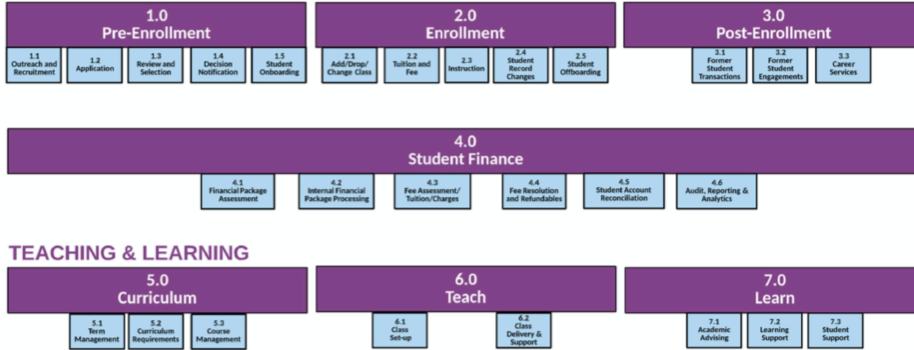Landscape Under a Sunny Sky
The idea of putting together a process landscape started as a desire to represent information about business processes across a large business area to stakeholders and decision makers in a visual, more digestible way, in order to inform work on the Enterprise Systems Renewal (ESR) program. From the start, ESR has been a combination of improving both UC San Diego’s technology and its core business and administrative processes.
The Purpose of Process Landscapes
Process landscapes answer three primary questions:- What is it that we do?
- How do we do it?
- Who does it?
Below is an example from the UC San Diego Student Information System Project. This one pager view shows the various process areas within the entire student administration system.

Each one of the purple boxes (level-1) is decomposed further into more detailed level processes represented in the second layer of blue boxes. Each level-2 box is further decomposed into level-3.
It's like peeling the layers of the onion, and not going deeper into any one area before identifying all processes within scope. In our experience, it is at level-3 where we have the right amount of detail to make informed decisions about evaluating the processes for further deep dives or making an intentional decision to carry forward with the current process.
How Landscapes Get Made
“It takes a lot of work to make something simple” - Steve Jobs
A process landscape cannot be created in silo. A process landscape comes together as a result of subject matter experts getting into a room (or a virtual room), and white-boarding their understanding of various capabilities offered in their areas. This discussion is skillfully guided by a process expert who helps tease out different aspects of complex administrative process flows.
It is expected for the process landscape document to go through multiple iterations and a process of curation before arriving at a place where it looks like an accurate representation of the business area.
A business process lead, assigned for each ESR project team, assumes ownership of gaining consensus on the final process landscape and attaining required approvals to make sure that the document is comprehensive and an accurate representation of the business area.
The high-level process landscape for the Student Information (SIS) above is the result of 15 workshops, 90-120 minutes each, engaging participation from around 200 SMEs. This work was further expanded leading to the creation of 170+ process maps documented over 200 sessions involving 233 SMEs.
Process Mapping by the Numbers
UC San Diego has developed the following number of process maps- Research Administration, 150+ processes
- Finance Administration, 150+ processes
- Student Administration, 170+ processes
- IT, 110+ processes
- HR, 200+ processes
These process landscapes have been viewed 57,000 times, meaning staff, administrators, subject matter experts and executives are actively referring to them to inform strategic planning and support day-to-day operations.
More Information on Process Improvement in the ESR Program
Check out the following articles that also touch on process improvement elements within ESR: